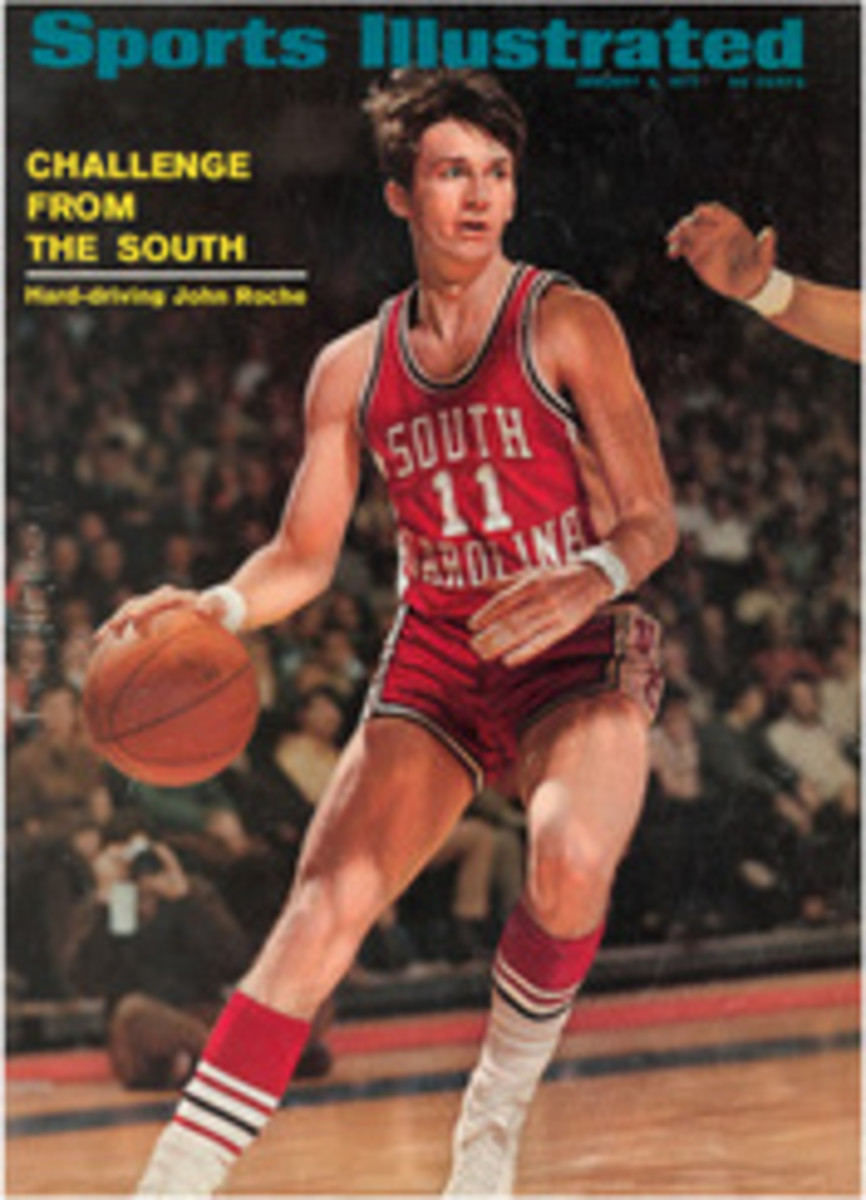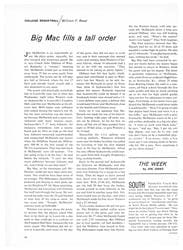
SCORECARD
THE FORESTS' PRIME EVIL
It has never been a secret that snowmobiles are somewhat noisier than a snowfall but, despite quivering eardrums and shattered nerves, little has been done to alleviate the problem. One reason is the juvenile aspect of snowmobiling: noise gives a feeling of power, and silent snowmobiles would be as hard to sell as silent motorcycles. Yet you would think snowmobilers might have second thoughts about all that noise after hearing (if they still can) of a study conducted by Canada's National Research Council, which says that not only hearing but safety, too, is jeopardized by the noise of the machines. The NRC says a snowmobile rider cannot possibly hear an automobile horn 10 yards away and adds that permanent auditory damage may result from regular daily use of a snowmobile at full throttle.
The Research Council claims that noise levels could be cut in half in some snowmobiles if they were equipped with a muffler, a silencer on the carburetor air intake and an extended engine cowling. "It is our opinion," the study concludes, "that noise reduction could be achieved in a production model...without excessive penalty to mechanical performance or cost."
Snowmobile manufacturers have yet to flood the public with machines incorporating the Canadian group's suggestions, but this does not mean that everybody is ignoring the noise problem. No, sir. A company in Michigan is proudly pushing an electric horn it has manufactured for use on snowmobiles with 12-volt batteries. It is "the loudest electric horn available to the snowmobile industry," says a press release, with "approximately 137 decibels of sound at four inches." Hopefully, ears will be more than four inches from the horn, but in case you were wondering how loud 137 decibels is, 130 is supposed to be the threshold of painful and possibly damaging sound. A pneumatic drill 10 feet away registers in the 90s; the sound level in a boiler factory is about 97.
Happy snowmobiling. We said, happy snowmobiling.
SPIN-OFF
The obvious signs of pollution are not always the only bad things that happen. A 5½-inch brook trout caught recently in Michigan had a distorted body—its backbone, belly and sides all crimped in like a balloon that has been twisted—because of a metal ring from a pop-top can that apparently had slipped over the fish's head when it was a tad and had restricted its midsection as it tried to grow to maturity. A sad and ugly thing to see.
NOW TO OMAHA
A few weeks ago (SCORECARD, NOV. 23) it was reported that Ben Kerner was trying to get Franklin Mieuli's San Francisco Warriors to play half their home games in St. Louis. Now word from Nebraska says that people there are trying to get Mieuli to make a 100% shift to Omaha. The Omaha group, which includes Mayor Eugene Leahy, has told Mieuli it will guarantee an advance sale of 2,600 season tickets, or about $500,000. This supposedly is more than the total grossed by three NBA teams last season. Rent for the 9,046-seat city auditorium would be about $70,000 less than the Warriors are now paying to play in three different sites around the San Francisco Bay Area. There would also be obvious economies in travel costs. Mayor Leahy estimated that total savings for the Warriors could be $300,000.
By coincidence, Mieuli and his Warriors were in Omaha in December for an NBA game (they lost to Cincinnati 124-113). The crowd was a disappointing 2,765. However, the game was competing with Monday night pro football and the Ali-Bonavena fight, and Omaha's attention was not so much on live basketball as it was on televised football and boxing. Local people insist that an Omaha team, or an area franchise that would play home games in cities like Lincoln, Kansas City, Sioux City and Des Moines, would be certain to make money. Since a major factor in keeping Mieuli from making the shift is the comedown in moving from his beloved, sophisticated San Francisco to home-folks Omaha, that is of the utmost importance. Sometimes money can overcome sentiment.
DOWNHILL ALL THE WAY
During the non-snow off season, Hank Tauber, coach of the U.S. Women's Alpine ski team, put his charges on a strict two-week diet. Women Alpine skiers tend to be sturdy and sturdiness has a way of slipping into plumpness, but Tauber said the purpose of the diet was only to put his racers at their best individual weight so that they would be stronger, more agile and more alert and thus gain maximum benefits from dryland conditioning. The diet, prescribed and supervised by Dr. Fred Schoonmaker, chief of cardiovascular surgery at St. Luke's Hospital in Denver, follows:
Women's Alpine Team Training Diet
Diet is for two weeks only. Abstain from everything not included and be sure to eat all of what is assigned rather than do without. No eating between meals. No alcoholic beverages. All vegetables without butter. Salads without oil. Lean parts of meat. Eggs should be poached or boiled. Coffee black. Tea clear. Basis of diet is chemical, and normal energy is maintained while reducing. Quantities are not important except as indicated.
MONDAY Breakfast: Grapefruit, one or two eggs, tea or coffee. Lunch: Two eggs, tomatoes, tea or coffee. Dinner: Two eggs, combination salad, one piece dry toast, grapefruit, tea or coffee.
TUESDAY Breakfast: Same. Lunch: Two eggs, grapefruit, tea or coffee. Dinner: Steak, olives, celery, cucumber, tomatoes, lettuce, tea or coffee.
WEDNESDAY Breakfast: Same. Lunch: Two eggs, spinach, tea or coffee. Dinner: Two lamb chops, celery, cucumber, tomatoes, tea or coffee.
THURSDAY Breakfast: Same. Lunch: Same as Wednesday. Dinner: Two eggs, cottage cheese, cabbage, one piece dry toast, tea or coffee.
FRIDAY Breakfast: Same. Lunch: Same as Thursday. Dinner: Steak, celery, cucumber, tomatoes, tea or coffee.
SATURDAY Breakfast: Same. Lunch: Fruit salad (put anything in it and eat as much as you want), tea or coffee. Dinner: Same as Friday.
SUNDAY Breakfast: Same. Lunch: Cold chicken, tomatoes, grapefuit. Dinner: Chicken, tomatoes, grapefruit, carrots, cabbage, tea or coffee.
Repeat for a second week. Weight should drop about 20 pounds.
COLOR
When the National Hockey League abandoned sober black skates in favor of more garish hues (SCORECARD, Oct. 5), it shattered tradition. Now such radical departures have taken another bastion: major league baseball, or at least the version of major league baseball played in Philadelphia. Granted, Charlie Finley's Athletics have been wearing eye-popping gold-and-green uniforms and white shoes for years now, but Charlie makes so much noise his uniforms are hardly noticed. On the other hand, almost anything stands out in Philadelphia, which is why this particular innovation is so important.
It began last spring when someone on the Phillies decided that conventional baseball shoes were stiff and tended to inhibit running. He asked a West German shoe manufacturer for help. Sensing a vast new market, the elves in the Black Forest turned out a baseball shoe that was not only lighter and more flexible, but utilized soccer-type cleats for use on artificial surfaces. And while they were at it, der elves made up a pair in a gleaming Burgundy red. That caught the eye of Bill Giles, the promotion-minded vice-president of the Phils, who decided that red shoes would be just the thing to top off (all right, bottom off) the Phillies' red-accented uniform.
Not to be outdone, the Baltimore Orioles made their move. The Orioles, who, despite being world champions, are somewhat overlooked in their home city (instead of attending ball games, folks there tend to go off to watch oysters being shucked or crabs caked), have just about decided to wear orange shoes next season. Orange, one quickly realizes, is more or less the dominant hue in the plumage of the avian, or real-life, Orioles. Who'll be next? The Yankees? Maybe in red, white and blue pinstripes?
ITS OWN REWARD
It's been a hard year on coaches—at least 25 major college football coaches have retired, resigned or been fired—but in one small corner of athletic endeavor coaching has proved a blissful experience. Here, verbatim, is a letter from a small soccer player to his coach:
"Dear Mr. Bick:
"You have been very nice to the team. And we lost the first game to the Roadrunners 7-0 and we lost the second game to the Dusters 2-1 and then we won the third game 1-0 and we lost to the Jagurs 7-2 and then we tied the Roadrunners 1-1 and then we tied the Alligators 0-0 and we lost to the Jagurs 3-1 and then we won to the Alligators 2-1 and we won to the Beavers 1-0 and you have made us come a long way. And I thank you. Sincerely yours, Doug Bartolf."
OLD BLOOD AND GUTS
And then there are other coaches. In Toronto a man walking along the side of a hockey arena toward its entrance heard a coachly harangue coming from a window over his head. It was obviously a pregame pep talk. "If there is any blood on any sweaters," the coach cried, "it's going to be on their sweaters, not on ours. I want you guys to cream those bums when they try to come down the boards. Really pile them into the boards and teach them a lesson. I want you to go out there and kick the____out of them. I want you guys to hit these bums so hard they'll be scared to come back in the rink."
Appalled but fascinated, the listener checked the location of the window, went inside, found the door to the dressing room and waited to watch the angry warriors pour forth to do battle. When the door opened out came a team of Peewees—boys 11 and 12 years old.
RISK
The American Medical Association has released details of a study on injuries in college football. The study, which covered 3,019 varsity players at 44 universities in every major conference, found that 46% of all players were injured during the season, half of them severely enough to be hospitalized or out of uniform for the next game. Some other findings:
Knee injuries were the most common; ankle injuries were second.
More serious injuries were incurred in preseason practice than in regular-season games.
The first and fourth quarters were much the safest; 67% of all injuries occurred in the second and third quarters.
Highest-risk positions on offense were fullback and tailback. Safest on offense were tackle and tight end.
Highest-risk position on defense was linebacker. Safest were halfbacks and safeties.
A player making a tackle or a block was more apt to be injured than the person being tackled or blocked.
ILLUSTRATION
THEY SAID IT
•Mercury Morris of the Miami Dolphins: "In practice I try to play it like a game. Other guys run 10 to 15 yards. I score every time. I run away from guys that aren't there, but they're going to be there in a game."
•Julius Boros, who will become resident pro at the new country club, Aventura, near Gulfstream Park in Florida, suggesting a casual attitude toward the game: "What if your shot isn't perfect? You're out there for some fresh air, a good time and some exercise. No game is worth the agony some golfers go through. When you lose your temper after missing a shot the chances are you will miss the next shot, too."
•Rolland Todd, coach of the Portland Trailblazers, on UCLA's Sidney Wicks: "I don't recall a forward coming into the NBA in the last 20 years who had the ability of Sidney Wicks. Wicks would fill about three vacancies on our club. He has been playing against NBA players on the Los Angeles playgrounds since he was about 13."

